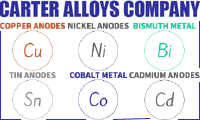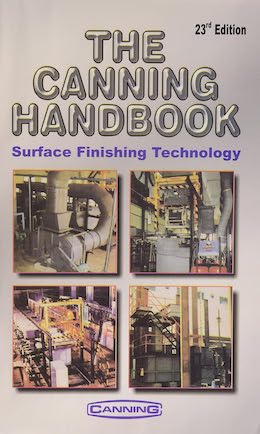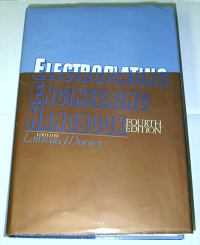
Curated with aloha by
Ted Mooney, P.E. RET

The authoritative public forum
for Metal Finishing 1989-2025

-----
LHE Cadmium plating -- Problems & Solutions
⇩ Related postings, oldest first ⇩
Q. I'm working with the Navy and need to incorporate the use of cadmium plated grade 8 fasteners (#10-24, and °- 28). What are the proper call-outs I should use to ensure that the fasteners have the smallest amount of embrittlement possible? Is AMSQQP416 good enough? Do I need to specify post plate processing?
Any suggestions where I can find fasteners processed in this manner.
Patrick Fischer-Carne- DeLand, Florida
2001
A. At United Airlines, low embrittlement cad is critical. We use a low embrittlement chemistry (non-bright), check for contaminants that would influence the hydrogen entrapment weekly (Lawrence Gauge) and bake after plating. There are few cad platers left and fewer still that could comply with your embrittlement request.
Jeanne KitazakiUnited Airlines - San Francisco, California
Q. We are experiencing powdery LHE cadmium deposits which seem (after trials) to be attributable to an excess of iron contamination from steel anode baskets (the current density used is 60-80 A/ft2 - an aerospace requirement). Does anyone use titanium anode baskets? If so which thickness, etc. Any help much appreciated.
Marilyn WhiteProcess technician - Gloucester, Glo'shire, UK
2004
A. You cannot use titanium anode baskets in an alkaline solution. The titanium will "anodize" while the current is on and as the coating forms you will see the amps fall off (unless the voltage is automatically increased). Then when the current is turned off the oxide will fall off as a white powder; then when the current is turned back on the anodizing will slowly begin again and continue until no current passes at the voltage that is impressed.

Robert H Probert
Robert H Probert Technical Services
Garner, North Carolina

Q. Stainless steel has the same problem, so any idea what material is suitable for Alkaline solution?
Mark Ong- Singapore
2004
A. Mild Steel.

Robert H Probert
Robert H Probert Technical Services
Garner, North Carolina

A. Hi Marilyn,
I am afraid you can only use steel baskets; however they are not the problem. We have 20 year old cadmium solutions and still no problem. Have the supplier analyse and adjust basic chemistry and check for any porosity in the base metal.
All the best,

Trudy Kastner
electroplating service - Durban, KZN, South Africa
Low Embrittlement Cadmium has undesired bright appearance
I am having some troubles with my cadmium LHE bath. In my periodic test coupons, there are some areas of the coupons that are bright (normally just in one side of the coupons). We already performed metallic and organic decontamination and some electrical tests. Can you please give me some suggestions in order to solve the problem?
Thanks in advance.
Plating shop technical support - Lisbon, Portugal
2007
A. Many experienced and generous platers, technicians and scientists participate here but you are asking for mind reading, Carla. What is your process and chemistry? What are your parameters? What is your substrate? What type of pre-plating process are you using? What have you tried to solve the problem?
Guillermo Marrufo-Mexico
Monterrey, NL, Mexico
A. Hi Carla. Please see letter 2114, "Cadmium Plating: Brightness = Embrittlement?" for some good insights. Remember that most dull plating can be easily burnished/buffed to brightness. Is there a chance that these 'coupons' are exposed to any sort of mechanical motion that could be burnishing those areas?
Regards,

Ted Mooney, P.E.
Striving to live Aloha
finishing.com - Pine Beach, New Jersey
2007
Q. We prepared Low hydrogen embrittlement cadmium plating bath volume 400 L with:
CdO 20 g/L; NaCN 162 g/L; NaOH 12.0 g/L.
We have two problems:
1. Lab analyses finds concentration of 90 g/L of cyanides, and in reality we made concentration of 162.5? I wondering how they cannot find real concentration by titration with HCl?
2.We had in bath stainless steel anodes, unfortunately it happened they start to dissolve under voltage of 2V, and solution become dark orange colored. It means that we have now Fe Cr Ni ions in electrolyte.
Can we use this electrolyte for further Cadmium plating considering this fact? I'm afraid not, but I would like to check with some one.
Thanks in advance.
engineer - Belgrade, Serbia
June 29, 2010
Q. I 'm an engineer for plating.
We have prepared electrolyte (Volume 400 liters) for Low hydrogen embrittlement cadmium plating with:
20kg CdO; 65kg NaCN; and 11 kg NaOH.
Expected concentration are: Cd 50 g/L; NaCN 162.5 g/L; NaOH 27.5 g/L
Found concentration by titration: Cd 45.45 g/L; NaCN 99.17 g/L; NaOH 38.92 g/L (expecting because of chemical reaction)
1. Question: How this titration cannot find the real concentration of NaCN?
We had stainless steel sheet anodes in this electrolyte, unfortunately it happened that they start to dissolve electrolytically because of contact with rectifier and solution turns to dark orange color. It seems that we have now Cr, Ni, Fe, etc ions in solution.
Trying to purify this solution we plate some metal sheets and cadmium plate looks visually good.
2. Question: Now I'm wondering is it possible to use this electrolyte in the future because of this metal ions of Cr, Ni, Fe, etc.?
engineer - Belgrade, Serbia
A. Vesna,
You seem to have some fundamental problems with understanding your process. This is going to make control of the process near impossible.
Firstly, unless there was a high cadmium content that needs reducing you should be using cadmium anodes, not steel.
You need to tell us your exact analysis method for cyanide. It sounds to me that you are probably only measuring the free cyanide content, or maybe the calculation is slightly wrong and your result is being expressed as CN rather than NaCN.
The foreign ion contamination is a little harder to deal with, it will really depend on how much contamination that you have in the bath. The standard method of removing contaminating ions is by a process called "dummying out", whereby you plate a very large area at very low amps over a period of time to reduce the contamination. If the contamination is very high then this method is impractical. I would suggest that you would have to discard the bath and start again if this is the case.
I would suggest you get hold of one or two books on plating. The Canning Handbook has a very good chapter on cadmium plating and its faults. .
The Electroplaters Engineering Handbook is also another useful publication and well worth having..
Both texts also have analysis methods so that you verify that your analysis technique and calculation for the CN is correct.
Aerospace - Yeovil, Somerset, UK
Q. Dear Brian,
Thanks a lot for trying to answer my question. Thanks for recommendation of books.
We have not started with using the bath because it's new and we made first controls. Bath is made up by Boeing prescription, and concentrations are much higher than usual for bright cadmium plating baths.
Steel anodes can be used for certain occasions in accordance with my books and Boeing procedure.We are buying Cd anodes.
In books I have found for bright cadmium plating that presence of Fe , Ni and Cr ions do not disturb the Cd plating. But considering the redox potential for Fe and Ni, I am afraid they will deposit at the same time with Cd.
Methods for determination of concentrations:
1. NaOH determined by titration with 1N HCl ⇦ this on
Amazon [affil links]
and sulforange indicator
2. Total NaCN determined by titration with 0.1N AgNO3 in presence of KJ and NH3 until solution becomes cloudy.
3. Cd metal determined by titration with EDTA, indicator Erio Chrome in presence of formaldehyde and HCl.
- Belgrade, Serbia
A. Vesna-
The iron won't significantly co-plate from the cadmium bath and it will accumulate in the bath over time especially if you use steel anodes. I wouldn't worry about it unless it get's over 1 g/L or so. Nickel will co-plate somewhat and in fact it is a main ingredient in the common brightener systems used in bright cad baths. For an LHE bath, you shouldn't have too much or it will have a negative effect on the porosity of the plate. You should find the source of the nickel contamination and eliminate it from your system. It is important to note that in a cyanide solution the metals are present as anionic complexes, not as metal cations, so your potentials are different than you may have read. As far as you analyses go, I don't see anything wrong with what you have written. You may want to also provide us with your sample volume and your factor so that we could verify that there aren't any math errors.

Jon Barrows, MSF, EHSSC
Independence, Missouri
A. There is a chemical reaction between the cyanide and cadmium to form a complex salt of cadmium cyanide. This type of cyanide complex can be analyzed thru distillation method only.
To prove this, make a small equivalent solution of NaCN & NaOH, no cadmium Oxide and titrate for cyanide. Good luck,
- Mays Landing, New Jersey, USA
A. Hamilton,
The cyanide is easily titratable with silver nitrate titrant. The silver displaces the cadmium from its complex as you titrate, as the silver complex is thermodynamically preferred. The end of the titration is signaled by the cloudiness that forms when excess silver reacts with the iodide from the KI that was also added (along with ammonia). When there is excess silver, there is no more cyanide (free or complexed). This titration is the standard throughout the industry and it can be verified as you have suggested. A distillation procedure would also work, but it is too complicated and time-consuming for most shops.

Jon Barrows, MSF, EHSSC
Independence, Missouri
A. Vesna,
I am still interested in finding the missing "cyanide". I am confident in your math. Is it possible for you to run a simple test? Add & dissolve three grams of CdO in 100 ml of the cadmium plating solution, titrate for cyanide. If the silver displaced all the cadmium in the cyanide complex, there should be no change in the cyanide concentration. However, if the silver did not displaced all the cadmium, then your cyanide analysis will be lower.
Good Luck,
- Mays Landing, New Jersey, USA
Q. Thanks for help. I will try this small experiment with CdO addition.
I got the concentration of foreign ions in this solution (µg/L=micrograms per liter ; g/L= grams per liter):
Silver Ag <0.1 µg/L
Copper Cu 19.0 µg/L
Potassium K 67.0 µg/L
Calcium Ca 3.8 µg/L
Magnesium Mg 0.1 µg/L
Barium Ba 0.2 µg/L
Strontium Sr 0.1 µg/L
Cobalt Co <0.1 µg/L
Nickel Ni 6.2 µg/L
Lead Pb 0.4 µg/L
Zinc Zn 6.8 µg/L
Chromium Cr 22.2 µg/L
Iron Fe 112.6 µg/L
Aluminum Al 45.0 µg/L
Manganese Mn 0.6 µg/L
Cadmium Cd 24.87 g/L
Sodium Na 98.5 g/L
I do not know whether some of metal ions bother Cd deposition and Cd plate quality.
- Belgrade, Serbia
July 20, 2010
A. Hello Vesna. Those contaminant levels will not be a problem for the plating quality. Actually, nothing there is anywhere near being a problem, so there is no need to look any further at the micro-level constituents. Just make sure that you are measuring the main ingredients properly -- NaCN, Cd, NaCN:Cd ratio, and NaOH. The most important thing is the ratio. The ideal ratio will depend mainly on whether you are doing rack or barrel plating. I like about 4.5:1 NaCN:Cd for rack LHE plating.

Jon Barrows, MSF, EHSSC
Independence, Missouri
![]() Dear Jon,
Dear Jon,
Thanks, you have supported me with your suggestions.
I had to check with Boeing all results, and they said the same as you for these metal impurities.
I will try to manage this NaCN:Cd ratio within the concentration limits.
- Belgrade, Serbia
Multiple threads merged: please forgive chronology errors and repetition 🙂
Poor and Uneven LHE Cad Plating
Q. Hello,
I'm currently a student working for an electroplating company over the summer. The LHE Cad tank runs pretty poorly and they want me to optimize the conditions. The tank is about 400 liters with titanium baskets and runs at 20 amps/ square foot. The concentrations are as follows: NaCN= 163 g/L; NaOH= 10.7g/L; CdO=24.5; Na2CO3= 47.17g/L. The only improvement I have been able to make so far has been increasing the NaOH concentration to 22.5 g/L. Any advice would be greatly appreciated.
Student - Ontario, Canada
May 25, 2011
A. You cannot use titanium anode baskets in a cyanide solution.

Robert H Probert
Robert H Probert Technical Services
Garner, North Carolina

A. Correction, Robert. Titanium baskets have been used in Boeing's Ti-Cad cyanide process for decades. Still, if the bath is LHE and not Ti-Cad, I agree that titanium baskets are not appropriate.

Jon Barrows, MSF, EHSSC
Independence, Missouri
A. What specification are you plating to? At first glance, your Cd metal is a little too low, but your NaCN is way too high. The ratio between NaCN to Cd is more important than the concentration and should not be more than 5 parts NaCN to 1 part Cd metal (not CdO) for LHE plating. Your hydroxide looks a little bit low. The carbonate is good where it is. For starters, I would add more CdO. This will do lots of good things at the same time. It will lower your free NaCN, get your ratio a little bit back into line, and increase the NaOH content. If you are following a particular specification, which I am sure that you must be, you would of course have to defer to whatever it says.

Jon Barrows, MSF, EHSSC
Independence, Missouri
A. Good day Greg.
From your data, it seems the NaCN is a little high, I would think the efficiency is a little low. Why not take an as is solution sample and plate a test panel, cut this solution 30% and add CdO to 28 g/l, NaOH 17.25,(NaCN @115 g/l) in the lab and try adding some carbon and filter then plate another panel and compare? Keep in mind Na2CO3 will rise on its own as this is normal during electrolysis. This 30 % reduction will give you a comfortable Na2CO3 concentration also.
What is your bath temperature? I would try 75 °F. Hope this helps.
Regards,
- Toronto Ontario Canada
A. Your NaCN is very high - our upper limit is 150 g/L, with a target of 118.5 g/L. Try dropping that and check the results.
Sean Mackay- Vancouver BC Canada
![]() Thank you for all the suggestions. I just have one more question ... I read that the anode to cathode ratio should be 2:1. Is this true?
Thank you for all the suggestions. I just have one more question ... I read that the anode to cathode ratio should be 2:1. Is this true?
- Fort Erie, Ontario, Canada
LHE Cadmium vs. Ti-Cad Plating
Q. I would like to know the advantages and disadvantages between Ti Cad and LHE Cad.
Syed ZamanNdt Nadcap - USA
December 13, 2011
December 19, 2011
TUTORIAL/ACRONYM:
For those not familiar with the process, we should note that Ti-Cad plating is not an alloy plating (as the abbreviation might sort of imply).
Rather, it is a composite plating with tiny particles of titanium occluded into the cadmium plating, apparently as an aid to help hydrogen escape.
A. Syed,
Your post is rather abstract so it will be impossible to give you an answer, but here are a couple of bits of info:
Ti-Cd plating can be a right royal pain in the behind to control properly, needs investment in some good plant and needs constant analysis. This makes the coating considerably more expensive than conventional cadmium.
LHE cadmium doesn't require any specialist equipment and I do know of companies that use the same solution for conventional and LHE cadmium, it's all in the way it is applied.
Both Ti-Cd and LHE cadmium are used for the ability to diffuse the hydrogen out much easier than conventional cadmium.
Without knowing more about what you want the coating to do I certainly can't advise anything more.
Aerospace - Yeovil, Somerset, UK
LHE CAD plating solution turns white when current is on
Q. Recently when the plating tech turn the current on to plate parts in the LHE bath, the solution becomes cloudy and white and goes back to opaque (clear) when there is no current. The parts are meeting specs but the techs do not like it when the solution becomes cloudy. Why is it doing it and how can we solve it?
Patrick Spearplating lab tech - Howell, Michigan USA
October 18, 2016
Porous cadmium plating specs needed
Q. Hello there, I am a special process engineer in an aerospace surface treatment facility in Pakistan. We have been doing alkaline cadmium plating on aerospace parts for long but there has been a specification change recently requiring us to do "spongey", "porous" and "loose-hole" cad plating. My questions are:
1. Do these three names refer to the same process?
2. How to introduce porosity in the plating? Do we reverse current polarity?
3. What are the general porosity profiles for aerospace fasteners?
4. Do we need to change bath composition or the one being used for cad plating can be used for porous, spongy and loose hole cad plating as well just with reverse polarity?
5. What should be the current density and immersion times?
6. How is the quality checked? Are there visual standards for that?
- Kamra, Pakistan
January 3, 2020
adv.: Supplier of Copper Anodes, Nickel Anodes, Bismuth Metal, & Other Metal Products for Industry & The Arts

Q, A, or Comment on THIS thread -or- Start a NEW Thread


